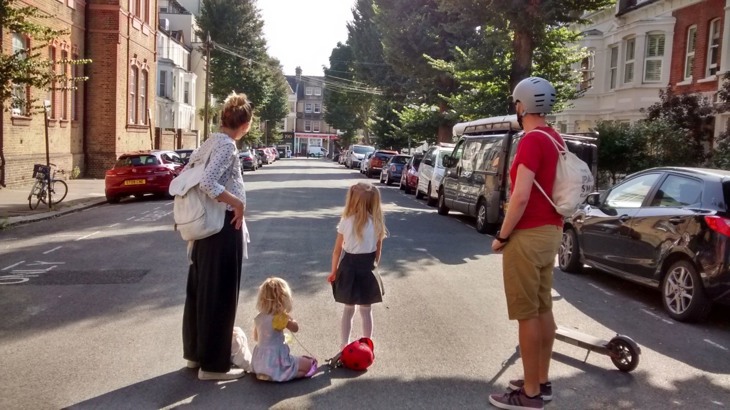Sustrans managed two School Streets projects in Hove over seven weeks in autumn 2020. The School Streets initiative limits through-traffic on roads outside school entrances during school opening and closing times. We put up temporary barriers to stop traffic during these times, although local residents and businesses were allowed access along with essential vehicles.

Removing through-traffic from the road outside a school makes more space for children to walk or cycle to school.
2 schools
We worked with to implement School Streets
7 weeks
The timescale of the project
3 closures
Took place daily
99 sessions
Run by volunteers as part of the project
These projects were part of an initiative to ensure a safe return to school after the nation-wide lockdown earlier in the year.
The aim was to minimise crowding around school entrances to reduce the risk of spreading coronavirus infection.
Children and parents could spill out safely onto the road, rather than being pinned in by parked or idling cars.
The road closures also gave children, school staff, parents and local residents the experience of traffic-free roads and encouraged walking, cycling and scooting to school.
The crucial role of volunteers
Sustrans volunteers were crucial to the smooth-running of these School Streets.
Volunteers moved and stewarded the barriers, helped permitted vehicles through the closure and built relationships with the local community.
The schools staggered their opening and closing, again to prevent crowding around the school entrance. This meant volunteers were needed for up to an hour each time.
They attended up to five closures every week, demonstrating a great commitment of time and enthusiasm to this project.
We asked existing Sustrans volunteers in the area to help us run School Streets as well as recruiting volunteers, especially for the project.
Our Project Officer spoke to all our volunteers before they joined School Streets and each volunteer had to attend an hour’s training with a traffic management company before taking part. We also offered informal, in-the-role training.
14 volunteers
Took part in the project
14 hours
The amount of training that was delivered
226 hours
Given by volunteers to the project
Our volunteers really enjoyed supporting a tangible, straightforward project to help their community at the same time as promoting active travel to and from school.
Their commitment was matched by what they gained from the project, such as feelings of connection and purpose during the pandemic.
One volunteer was working entirely from home and said that she really valued helping with School Streets as it gave her the motivation to get out of the house on a regular basis.
Another enjoyed the whole experience, “Meeting people and seeing kids/adults savour the safe streets whilst cycling/scooting down them.”
Taking back the streets outside schools
Children and parents enjoyed the freedom of School Streets. One little girl even took the opportunity to picnic in the middle of the road.

Removing through-traffic made space for families to enjoy their surroundings.
And we had positive feedback from local residents.
One volunteer recorded that their best experience was “a resident coming up and thanking us for finally making the road safe at school entry and exit times.”
Teachers and school staff also saw the benefits of School Streets.
The community embraced the change
The school community and residents really embraced School Streets. Some people felt nervous initially and had some concerns. But people quickly settled into the new routine of the project.
People understood the purpose of the scheme and respected the road closures. Both the school community and local residents appreciated what it gave them.
Demonstrating the value of School Streets
This was an intensive project that achieved its aims of allowing children and parents to spread out around school entrances to minimise the risk of Covid-19 infection.
Along the way, it gave people the confidence to walk, scoot and cycle to school. And local residents supported the scheme.
The project demonstrated how effective a School Streets scheme can be. But it also showed the need for a longer-term solution that requires less commitment from volunteers.
While the volunteers were what made this scheme work, asking for that level of commitment over a long period would be unsustainable.
That is why we call on the UK Government to enact part 6 of the Road Traffic Management Act as soon as possible to give local authorities the powers to enforce school streets, as part of the Covid-19 active travel measures.





